Lars von Trier’s film Melancholia is a story about a woman who has ‘melancholia’and also, rather coincidentally a planet called Melancholia that is approaching Earth. The opening starts with a sequence of slow-motion images that show us what will happen at the end of the film; the planet Melancholia colliding with the Earth.
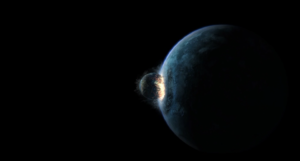
The film is divided into two very distinct parts.
The first is focused on Justine who is getting married to Michael in grand style in an old castle, but as the wedding evening progresses, Justine’s depression starts to get the better of her and she stumbles from one disaster to another; arriving two hours later for the reception, visiting her horse instead of the guests, taking a bath half way through the reception and sleeping with a near stranger on a golf course. By the end of the first part, Justine’s marriage has ended (before it has started), she has effectively lost her job and is incapable of completing even the smallest of tasks and so spends her time sleeping.
During the second part, the focus is on Justine’s sister Claire. During the first part, Claire appeared the more sensible of the two sisters and took charge of looking after Justine, even though at times she resented it. As it becomes more and more apparent that Melancholia is going to collide with Earth, Claire becomes gradually unhinged by fear and the knowledge that there is nothing she can do to stop what is going to happen. Justine, on the other hand, becomes calm and caring. It is Justine who helps Claire and her son to face the final moments of their lives.
One of the fascinating parts of this film is its opening sequence which is a series of slow motion images that show the main characters and then images of Melancholia approaching Earth. The images look almost like Renaissance painting that have been merged occasionally with a style similar to Salvador Dali. The shots were filmed at a very high frame rate, enabling you to see details that would not normally be seen at a 25 frame/second rate. According to von Trier, these images are emotionally generated and show what could be going on in Justine’s mind as she is the one person who is sure that the world is coming to an end. In one of the extra interviews for this movie, there are a few shots of the storyboard for this sequence, which was great to see as an example of professional storyboarding.
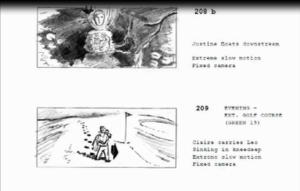
In one of the images, Justine is lying on her back, floating in a lake – this is the image that is used for the cover of the DVD and the advertising for the film. This image is reminiscent of John Millais’ painting of Ophelia. In both the painting and the image of Justine, they appear calm in the face of death. There is possibly another link with this image later in the film – after the failed wedding, Justine stays with Claire and her family in the castle. One evening she gets up and goes out to the river where she takes off all her clothes and lies on the river bank – almost basking in the light coming from Melancholia.
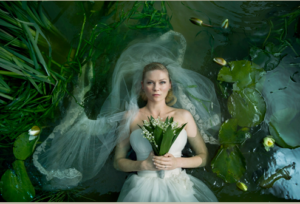
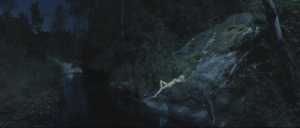
Another image that in the opening sequence shows Justine trying to cross the screen from right to left (i.e. backwards digression) in her wedding dress. There are black ‘roots’ that have wound themselves around her legs making it difficult for her to walk. This shot gives an earlier indicator that Justine’s wedding day may not as happy as it should be and at the same time allows the audience a glimpse possibly of Justine’s view of her marriage.
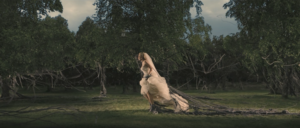
Another aspect of this movie is its filming style. In many of the shots, particularly during the first part, the camera is handheld and very jittery – almost amateurish. The pans are very fast, they don’t hold a character at the end of the shot and often don’t even compose terribly well. Von Trier did this on purpose. He wanted to create a sense of documentary coverage, where the cameraman didn’t know in advance how the action was going to evolve and so couldn’t set the shot up in advance. Von Trier felt that this style of filming added a ‘live vibration’ to the scenes and in many instances kept what would normally be considered faults or mistakes in the filming. What was also interesting is that the actors could not know what was going to happen with the camera either, so in effect, they simply had to forget about the camera and get on with the acting.
In one of the interviews with the Director of Photography, Manuel Alberto Claro, he explained that on a set with Lars von Trier, he does not give any direction to either the actors or the camera crew on the first take. After the first take, then everyone from the actors to the crew can make their suggestions and slowly adjustments are made so that the second take may be radically different to the first.
In terms of creating atmosphere, the first part of the film has predominantly yellow lighting and colours. This is intended to first give the impression of a joyful, happy occasion with lots of people and movement. As the first part progresses and the audience realizes that this is not a happy event, the yellow colour takes on a more sickly, over-the-top feeling. In the second part of the film, the crowds have disappeared and the family is left alone and are much quieter. The colours are now more blu-ish green, similar to the colour of the planet Melancholia.
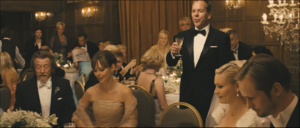
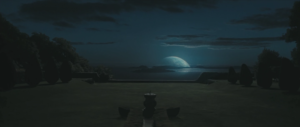
And finally, von Trier used Wagner’s prelude to Tristan und Isolde as the non-diegetic soundtrack to the opening sequence and some of the other scenes. This seems strange music for a film whose context is the end of the world because it is more appropriate for calmer more idyllic settings. However, I think von Trier uses this music to help the audience consider the end of the world in much the same way as Justine faces it – calmly and without fear.
Filmography
Melancholia [feature film, DVD] Dir. Lar von Trier. Zentropa Entertainments, Memfis Film, Denmark, 2011. 130 min.
